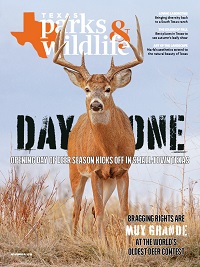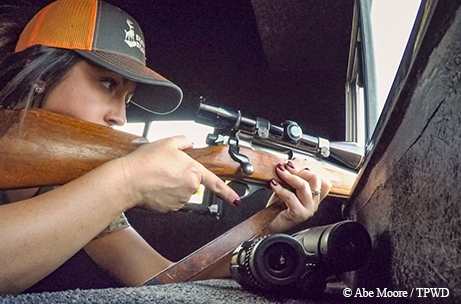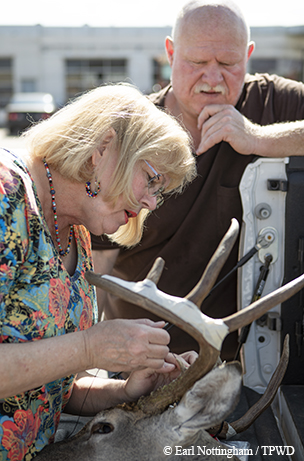
Opening Day
Small-town Goldthwaite comes alive with the opening of deer season.
By Whitney Bishop
It's rush hour in Goldthwaite. A steady stream of pickups pull into this small Central Texas town, piling up at its two main stoplights.
“Come deer season, it’s like Easter Sunday in the Baptist Church here,” says visitor Stan Laukhuf, who drove in from Dallas.
Tomorrow is opening day, a hallowed day for hunters that marks the beginning of general deer hunting season. From November through January, Goldthwaite will be a hub of activity as hunters come to chase the bucks that are chasing the does.
“We are getting ready for the craziness to start happening,” says Rodney Spies, owner of the popular-with-the-hunting-crowd Mills County General Store. “People are wanting to buy a hunting license. ‘Oh, I forgot my camo shirt and I need a box of ammo.’ It’s gonna be a lot of fun.”
Funny thing is, 50 years ago there were hardly any deer here at all.

Lindsey Head's son plays with a set of antlers.
Buck Boom
“The first deer sightings were sometime in the ’60s in this area,” says Mike Miller, TPWD wildlife biologist.
This part of Texas was better known for its angora goats, which produce the silky wool known as mohair. But in the mid-20th century, another animal came calling.
“The increasing amount of brush has made deer habitat where deer habitat didn’t used to exist, so we’ve seen an increase in deer density over time,” Miller says.
The eradication of the screw worm helped the deer population increase. But while deer numbers were rising, the town population held steady. Today, Mills County has just 600 more residents than it did in 1900. About 1,800 people live in Goldthwaite, located about halfway between Lampasas and Brownwood.
“We’re happy to see the green of the camo because it brings the green dollars into this little county,” says Steven Bridges, publisher of the local newspaper, the Goldthwaite Eagle. “The feed store will be lined up two- or three-deep with folks getting deer corn. The motels and hotels have been booked up since last year. It’s also the lease money that helps a lot of these ranches that would otherwise be scraping by to try to make a living. They can make as much or more from just the deer leasing as they can from the ranching.”
The middle-aged newsman is the fifth generation of his family to own a Texas newspaper. He also serves as writer and photographer, overseeing a small staff. Tall, lanky and sporting a goatee, Bridges knows just about everyone in Goldthwaite. And just about everyone in Goldthwaite has been featured in the Eagle at one time or another.
“The kids and the old people and the deer hunting and the Friday night football — it’s still contained in the pages of the small-town newspapers,” Bridges says.
With hunters from across the state descending upon Goldthwaite, opening weekend is one of the biggest stories of the year.
Head to the Field
Opening day dawns through a thick fog. As the full moon fades away, the weather promises to be unseasonably warm. Across Mills County, hunters sit silently in their blinds, waiting for deer to appear.
One of those hunters is Lindsey Head, a 30-year-old with freshly painted nails who harvested her first buck, a nine-point whitetail, when she was 9 years old.

Lindsey Head takes aim at a deer.
“Even if you can’t see through the fog you know there’s stuff wandering around out there,” she whispers. “Then you’ve got to really listen for things. You know eventually the fog will lift, the sun will come up. Sometimes it surprises you how many deer are out there after the fog lifts.”
Head takes pride in harvesting fresh, healthy food for her 6-year-old son.
“It feels awesome to be able to go out and shoot a deer and provide your family with meat,” she says. “Plus, you know where the meat comes from. It’s all natural; there are no antibiotics. Most people think that girls need a man to do all their dirty work, but women are completely capable of doing stuff on their own, especially going hunting.”
Replenishing in Town
Just up the road, the staff at El Tapatío Restaurant is gearing up for the after-hunting rush. Hunters will start filing in around 10 a.m. after their morning hunt.
“Everybody’s like: ‘I’m ready for deer season. Deer season’s coming!’” owner Nancy Rodriguez says of the yearlong focus on this day. “You know, once it starts to roll around, like October, they’re just like, ‘OK, we’re getting prepared!’ Then the first of November hits, and here we are.”
On a typical morning during hunting season, the restaurant will go through 15 dozen eggs and at least 3 gallons of sweet tea.
Over in the heart of town, the Mills County General Store is ready for one of its busiest days of the year. The store evokes an earlier era when local businesses thrived in most small towns. Long and narrow, it’s packed with housewares and hardware, guns and gadgets, camo and candles.

Business starts to pick up at the Mills County General Store.
“There are a million things in the general store,” Bridges tells us, adding a local tip. “You just have to ask sometimes because it’s in some cubbyhole.”
Owners Rodney and Ginger Spies say that opening day of deer season is their Black Friday.
“Every hunter has a ritual,” Ginger explains. “They’re going to eat a big breakfast, then they’ll come in and they’ll mill around. Now, if they shot something, just like the guy that was in here a while ago — he was shaking, he was so excited. That’s not unusual. I feel it, too.”
Over the years, the Spies have noticed several changes in their customer demographics.
“Typically, on opening weekend 18 years ago you wouldn’t see a lot of kids, probably no wives,” Ginger says. “Now hunters have involved their families and it’s become a growing thing. Believe it or not, we sell a good many toys when hunting season starts. Something to do in-between the times when you’re out in the deer stand.”
The Big Bucks Roll In
In the spirit of the season, the store sponsors a Big Buck Contest. The hunter who brings in the buck with the biggest antlers — as measured by the store’s certified Boone & Crockett scorers — wins bragging rights and a Henry repeating rifle.
Bridges is on hand from the Eagle with camera and notepad to document the action.
“My job is covering the deer hunting, which is the news: who shot what, where they’re from, how long they’ve been hunting here, what kind of rifle they shoot,” he says.
“Was it chasing females? Was it eating at the corn feeder? To some of our readers, it’s just as important as anything else in the paper.”
In the opening weekend edition of the Eagle, 20 of its 40 pages will be devoted to deer hunting. The paper’s special “Hunting Guide” has a readership of more than 15,000 in a county with 5,000 people.
Right around 10:30 a.m., the big bucks start to roll into the parking lot.
One of the first comes from Gary Barbar, a portly grandfather wearing denim overalls. He pulls up with a deer hanging from a hoist on the back of his truck. He shot it with his favorite rifle, nicknamed Ole Bad Breath.
Bridges chats with Barbar and snaps a few pictures. Later, he’ll caption the shot of the deer hanging from the truck “Only in Goldthwaite.”
Soon more hunters bring in their bucks. The biggest buck of the day comes from Walt Thompson, a young hunter pumped with excitement. Thompson’s buck scores 129, with an inside spread of 16 inches.
“When you first see the deer you get excited, sometimes you get scared,” Thompson says. “And when you’re about to shoot, most people get buck fever. That’s what they call it when you’re shooting and you’re shaking because it’s so big and you’re about to miss it. I was so scared I had to use my hand to close my eye.”

Mills County General Store owner Ginger Spies measures a buck brought in for the store's Big Buck Contest.
Growing Trophies
The bucks are getting bigger in Mills County thanks to a cooperative effort among landowners. Many have joined together to manage their lands for wildlife.
“Without an association you have a lot of individual properties,” TPWD biologist Miller says. “Some properties are large, some small — all following their own harvest rates, their own objectives. There can be a lack of trust in that situation. Hunters can feel like if they pass on a decent deer rather than letting them grow up, the deer may be harvested that same season on a neighboring property. But in these associations, there is that trust. They trust that when they pass on a deer that’s middle-aged, it’s going to grow up to be something better later.”
Miller has worked opening day for 20 years and consults with the landowner associations throughout the year. He gives harvest recommendations based on annual deer counts.
“We’ve seen over time that these deer, they’re larger now as far as antler growth,” he says. “We can tell by looking at the harvest data that they’re better deer than they used to be 10 years ago.”
One local landowner group, the Simms Creek Wildlife Management Association, represents close to 80 properties totaling nearly 55,000 acres.
“That’s pretty powerful when you have that kind of acreage,” Miller says. “You can start making a difference by making the right decisions both in terms of numbers of deer harvested and the types of deer that you harvest.”
Warren Blesh, president of the Simms Creek WMA, agrees.
“People want big bucks,” he says. “They’re willing to let the little bucks walk; that’s a change in culture in the last 20 years.”
Land that was once valued for its agricultural potential is now valued for its recreational opportunities. As deer quality improves, land prices go up and the demand for hunting leases increases.
“What’s been happening probably started around 2000 when prices soared from $600 an acre to more than $3,000 today,” Blesh says. “The people buying this land are mostly conservation-minded. They’re taking what could have been overgrazed land and turning it into restored pastures, new lakes and new ponds. To me, they’re making the land better than when they found it.”
Celebrating the Harvest
Meanwhile, back in Goldthwaite, the chili lunch is about to begin. A big tent is set up downtown with free nonalcoholic drinks, several kinds of chili and a gun raffle to raise money for a local scholarship. It’s Goldthwaite’s way of welcoming hunters.

Hunters gather at the community pavilion for a chili lunch.
“It’s amazing what hunting has to do with the community,” says Linda Crum from the Mills County Chamber of Commerce. “The hunters are from all parts of Texas: Longview, El Paso, Midland, Amarillo.”
On the outskirts of town, Wesley Head is too busy to celebrate. His wild-game processing business turns a hunter’s bounty into steaks, jerky and seven types of sausage (the favorite: jalapeño and cheese). During deer season he works every day for four months straight.
“I’ll usually get here somewhere around 8 a.m.,” he says. “A lot of times I’ll stay here until 9 or 10 at night, seven days a week, until the season’s over.”
By the afternoon of opening day, the temperature has reached 90 degrees. Hunters have been up since before dawn. Their adrenaline is spent; it’s time to recharge before the evening hunt.
Over opening weekend, Bridges will shoot several thousand photos and interview at least 100 people for the readers of the Eagle.
The Mills County General Store will sell 40 percent of its volume between the beginning of hunting season and Christmas.
Lindsey Head will harvest a doe, dreaming about the day her son will go on his first hunt.
And small-town Goldthwaite will prosper.

